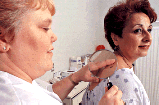PREVENTION: An Eye Towards Prevention
 LifeCheq nurse Kim Hagedorn examines a mole on Aramco employee Najwa
Hajjar-Artigue's back during an off-site cancer screening visit.
LifeCheq nurse Kim Hagedorn examines a mole on Aramco employee Najwa
Hajjar-Artigue's back during an off-site cancer screening visit. PREVENTION: An Eye Towards Prevention
 LifeCheq nurse Kim Hagedorn examines a mole on Aramco employee Najwa
Hajjar-Artigue's back during an off-site cancer screening visit.
LifeCheq nurse Kim Hagedorn examines a mole on Aramco employee Najwa
Hajjar-Artigue's back during an off-site cancer screening visit. Return to
Winter 98